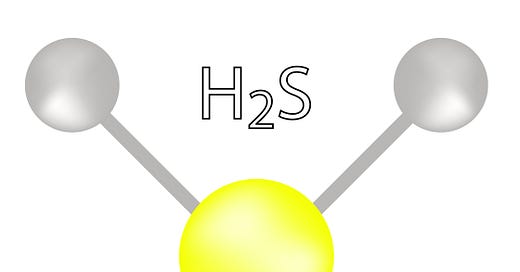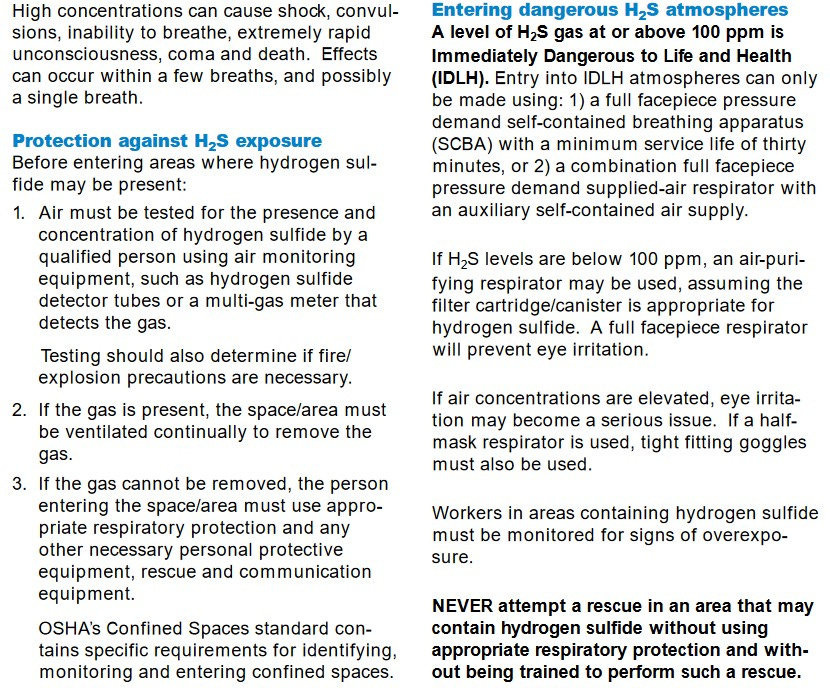Washington D.C. October 11, 2024.
The U.S. Chemical Safety and Hazard Investigation Board (CSB) announced today that it is launching an investigation into a fatal release of hydrogen sulfide at the Pemex petroleum refinery in Deer Park, Texas, which occurred yesterday, October 10. Two contract workers died as a result of the release, and an additional 13 workers reportedly were transported to local medical facilities.
Most readers of this blog are familiar with the hazards of hydrogen sulfide (H2S). Crude oil generally contains significant amounts of mercaptans, which break down to form H₂S. Therefore, H₂S is commonly found in oil refineries, pipelines and some chemical plants. It is also found in some sources of natural gas.
In spite of its familiarity, it is worth spending some time reviewing the properties and control of this dangerous gas.
This post is the fourth in a series. The first three posts are: Part 1, Part 2, and Part 3. Further information to do with management of toxic gases, including hydrogen sulfide, is provided in the book Plant Design and Operations.
The U.S. Occupational Safety and Health Administration (OSHA) has published a Fact Sheet for this widely used chemical. The Fact Sheet has two sections: one to do with the properties of H₂S, the other with how to respond to a leak of this commonly-found and dangerous gas. Comments on the first section are provided here. In this post we take a look at the second section of the document.
Second Part of the OSHA Fact Sheet
Protection against H2S exposure.
Information to do with sensors ― both fixed and portable ― is provided in the third post in this series.
OSHA’s Confined Spaces standard contains specific requirements for identifying, monitoring and entering confined spaces.
The OSHA Confined Spaces Standard is 29 CFR 1910.146. It defines a Hazardous Atmosphere as follows.
Hazardous atmosphere means an atmosphere that may expose employees to the risk of death, incapacitation, impairment of ability to self-rescue (that is, escape unaided from a permit space), injury, or acute illness from one or more of the following causes:
(1) Flammable gas, vapor, or mist in excess of 10 percent of its lower flammable limit (LFL);
(2) Airborne combustible dust at a concentration that meets or exceeds its LFL;
Note: This concentration may be approximated as a condition in which the dust obscures vision at a distance of 5 feet (1.52 m) or less.
(3) Atmospheric oxygen concentration below 19.5 percent or above 23.5 percent;
(4) Atmospheric concentration of any substance for which a dose or a permissible exposure limit is published in subpart G, Occupational Health and Environmental Control, or in subpart Z, Toxic and Hazardous Substances, of this part and which could result in employee exposure in excess of its dose or permissible exposure limit;
Note: An atmospheric concentration of any substance that is not capable of causing death, incapacitation, impairment of ability to self-rescue, injury, or acute illness due to its health effects is not covered by this provision.
(5) Any other atmospheric condition that is immediately dangerous to life or health.
In this section we quote some sections of the Fact Sheet, and add our own commentary.
A level of H2S gas at or above 100 ppm is Immediately Dangerous to Life and Health (IDLH).
Information to do with dangerous concentrations of H2S is provided by NIOSH (the National Institute for Occupational Safety and Health). Values that they provide are:
PEL: 20 ppm, 10 ppm peak;
IDLH: 100 ppm;
ERPG-1: 0.1 ppm;
ERPG-2: 30 ppm;
ERPG-3: 100 ppm
EEGL (10 minute): 50 ppm
EEGL (24 hour): 10 ppm
NEVER attempt a rescue in an area that may contain hydrogen sulfide without using appropriate respiratory protection and without being trained to perform such a rescue.
This statement applies to all rescue attempts.






